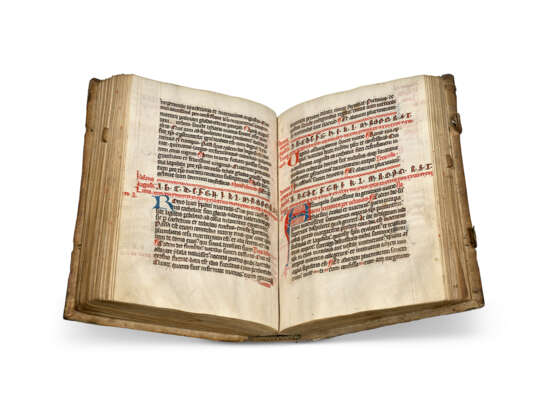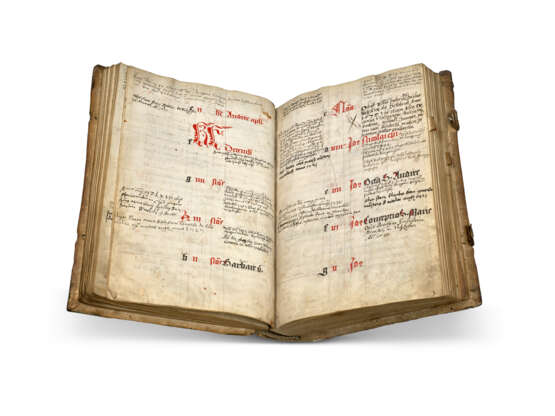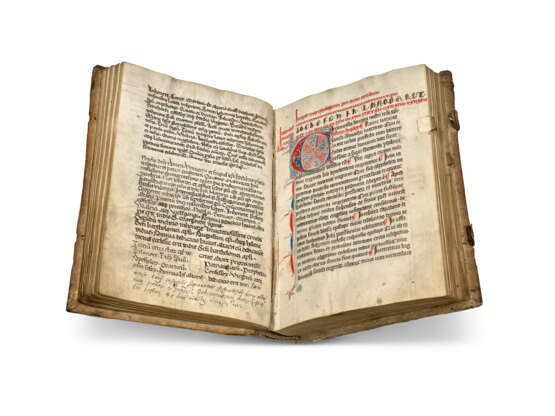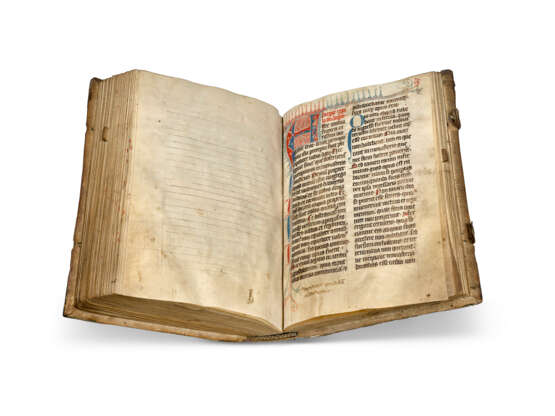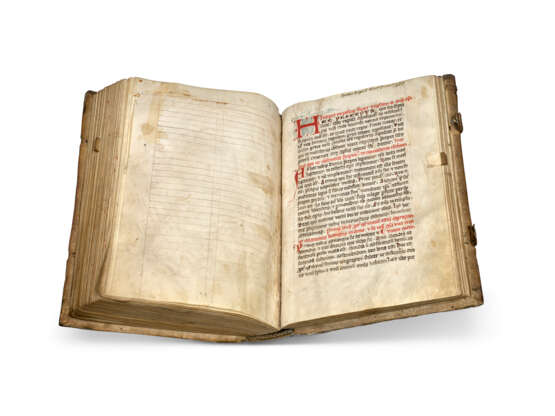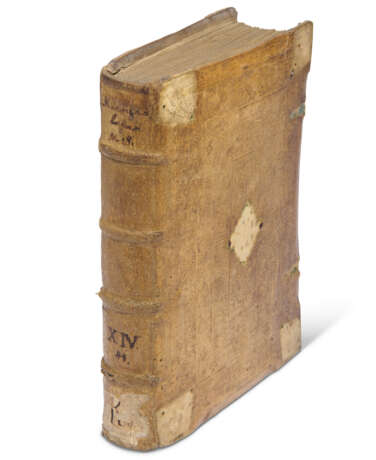ID 1349736
Lot 5 | The Book of the Augustinian Priory of Heilig Kreuz, Augsburg
Valeur estimée
£ 15 000 – 20 000
Calendar, Martyrology, the Rule of St Augustine, in Latin with some words in German, decorated manuscript on vellum, Augsburg [15th century]
A fundamental Augustinian book, containing a calendar recording the deaths of over 530 monks, sisters and benefactors associated with the Augustinian Priory of Heilig Kreuz, Augsburg and related religious institutions.
290 x 200mm. 168 leaves: 1-48, 57 (of 8, viii a cancelled blank), 6-158, 166, 17-218, 223 (of 4, iv a cancelled blank), 27-30 lines written in at least two hands, ruled space: 260 x 147mm, the Calendar dating to c.1400 and re-using leaves from an 11th-century manuscript (the text scraped off but still visible in places), the Martyrology and the Rule of St Augustine dating to the final third of the 15th century, rubrics in red, large penwork initials with elaborate flourishing opening the Martyrology and the Rule, initials alternately in red and blue throughout, Calendar heavily annotated with obits throughout (see Provenance), medieval tabs survive (marginal thumbing and staining, margins occasionally slightly cropped, some natural flaws to vellum, occasional small wormholes, final leaf creased). Bound in contemporary blind-tooled pigskin over wooden boards, stamped with the figures of the evangelists within ornamental frames (clasps, corner and centre-pieces lacking, very lightly rubbed, one corner chipped, the front pastedown a 13th-century manuscript). In a fitted red morocco box.
Provenance:
(1) Augustinian Priory of Heilig Kreuz, Augsburg: ‘Monasterii S. Crucis’ in a ?16th-century hand on f.2, and several obits referring to it as ‘nostri monasterii’. The scribe of the Calendar, which must date to the end of the 14th or very beginning of the 15th century, is re-using leaves from an earlier, possibly 11th-century, liturgical manuscript: we see this particularly clearly on f.1v. Over 530 obits have been added to the Calendar of Saints in a variety of different hands, the earliest dating to 1404, and going all the way into the 17th century. Most record the deaths of monks, deacons, nuns and other religious, but some include significant benefactors to the Priory. Several of the names can be traced in other literature and necrologies, for example Castulus Molitor, who dies in 1605 (here on f.2) is also recorded in SuSBA 2.Cod.Aug. 332 and Haemmerle, Nekrologium St.Georg, Nr.014. In addition to the entries for those religious at Heilig Kreuz, there is a preponderance of obits of monks from the Augustinian Abbey of Novacelle, or Neustift, in South Tyrol, near Bressanone, as well as the Augustinian monastery in Memmingen; the Abbey of St Ulrich and Afra in Augsburg; and Polling Abbey in Bavaria. Folio 38r-v contains transcripts of charters recording the consecration of Churches in Muttershofen, Hagenbach, and Döpshofen: St Nicholas in Muttershofen was, in fact, the mother monastery until it was abandoned.
(2) William Ewart Gladstone, Prime Minister (1809-1898): Hawarden Castle library label, MM I 9.
Content: Blank f.1; Calendar with added obits ff.2-37v; Charters recording the consecrations of churches ff.38-38v; Martyrology ff.39-123v; blank f.124; Rule of St Augustine ff.125-130; blanks ff.13-132; Hugh of St Victor, Expositio in Regulam S. Augustini ff.133-168v.
The present manuscript was evidently a functional document used as a record-book and rulebook over a period of at least two centuries by the monks of Heilig Kreuz. In addition to the liturgical calendar and necrology, which was kept constantly up to date, the manuscript contains two fundamental texts for every religious institution. Martyrologies offer the best source of information on the cult of saints in the Middle Ages, providing hagiographies following the calendar order of their anniversaries or feasts. Blessed German martyrs are included here. The Rule of St Augustine is an indispensable text for an Augustinian Priory, and appears in the present manuscript along with the commentary of Hugh of St Victor (c.1096-1141), the Saxon canon regular and leading medieval theologian.
| Lieu d'origine: | Autriche, Europe de l'Ouest, Europe |
|---|---|
| Catégorie maison de vente aux enchères: | Manuscrits médiévaux et de la Renaissance, Livres et manuscrits |
| Lieu d'origine: | Autriche, Europe de l'Ouest, Europe |
|---|---|
| Catégorie maison de vente aux enchères: | Manuscrits médiévaux et de la Renaissance, Livres et manuscrits |
| Adresse de l'enchère |
CHRISTIE'S 8 King Street, St. James's SW1Y 6QT London Royaume-Uni | |
|---|---|---|
| Aperçu |
| |
| Téléphone | +44 (0)20 7839 9060 | |
| Commission | see on Website | |
| Conditions d'utilisation | Conditions d'utilisation |
